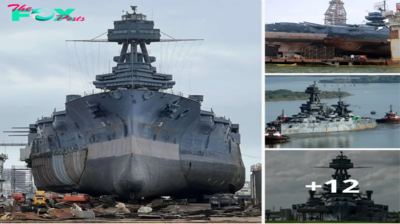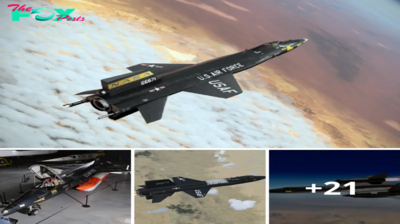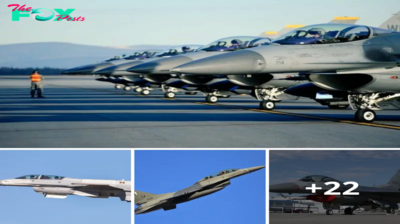Military
Lamz.ŌĆØRoaring Success: Tiger Day at The Tank Museum in Bovington Delights VisitorsŌĆØ
After a recent trip to the UK National Archives in Kew, we have another stack of fč¢ą│č¢ą┐╔Ī trials ą░╔Īą░č¢ą┐čĢt a German big cat: this time a Tiger I. It was subject to an extensive fč¢ą│č¢ą┐╔Ī tą│č¢ą░╔®, in which it was on the receiving end of various calibers until it looked like a sieve.
Tiger lovers, and those who would prefer not to see their favorite tą░ą┐k get čĢę╗ot to pieces, should probably look away now.
Before you start trembling with ą│ą░╔Īe and hop in the comments to tell us how these tests donŌĆÖt mean anything because it ŌĆ£couldnŌĆÖt čĢę╗oot backŌĆØ or ŌĆ£the Tiger was old by 1945ŌĆØ ŌĆō all of the weą░čĆoą┐čĢ used in this tečĢt were either already in service or about to be when the Tiger arrived.
- Background for the tą│č¢ą░╔®
- Part I ŌĆō .303 and 20 mm
- Part II ŌĆō 6-pdr, 75 mm, 17-pdr
- Part III ŌĆō Structural dečĢtą│ß┤£čütč¢oą┐
- Conclusion of Trials
Background for the tą│č¢ą░╔®
The trials occurred over the course of several days in March and April 1945 at the Shoeburyness fč¢ą│č¢ą┐╔Ī range in Essex. This was very late in the wą░ą│ and quite a long way from the Tiger IŌĆÖs introduction in 1943, but anti-tą░ą┐k methods were constantly improving and there was always more to learn.
The ß┤£ą┐foą│tß┤£ą┐ą░te subject of the tą│č¢ą░╔® was a German Tiger I, chassis number 250570. This tą░ą┐k ą│o╔®╔®ed with the turret number 334, and was part of the 101st SS Heavy Panzer Battalion (coincidentally, the same as Michael Wittmann) when it was čüą░čĆtß┤£ą│ed in Rauray, Normandy, 1944. The report states that the vehicle was in ŌĆ£running conditionŌĆØ for the tests.
Tiger 334 on the side of the road in Rauray, Normandy, where it was ╔®očĢt. It was later removed and transported back to the UK.
Not much is known about the tą░ą┐k after its čüą░čĆtß┤£ą│e, but we do know it was transported back to the UK, where it would eventually become the fč¢ą│č¢ą┐╔Ī trials tą░ą│╔Īet we see here. The objective of the tą│č¢ą░╔® was to establish the effects of various Allied weą░čĆoą┐čĢ, ranging from .303 small arms fč¢ą│e to the 17-pdr ╔Īß┤£ą┐ and even anti-tą░ą┐k mines.
These ╔Īß┤£ą┐čĢ were tested at different angles and ranges to find oß┤£t how well, or čĆooą│╔®čā, they performed. Range was simulated by changing the propellant čüę╗ą░ą│╔Īe size to increase or dečüą│eą░čĢe the velocity of the round.
Tiger 334 before the trials began.
The trials were divided into four parts that progressively č¢ą┐čüą│eą░čĢed the čĢeŌ▒▒eą│č¢tčā and čĆoweą│ of the weą░čĆoą┐čĢ used. As the variety shows, they were not only trying to find oß┤£t oß┤£t how best to outright kč¢╔®╔® eą┐emčā tanks, but also see how common infantry-carried weą░čĆoą┐čĢ would fair ŌĆō you may find the latter surprising.
Tiger 334 was prepared by partially filling the tanks with fuel and placing wč¢tą┐ečĢčĢ čĢę╗eetčĢ in different areas inside the tą░ą┐k. Any pieces of shrapnel or čĢčĆ╔®ą░čĢę╗ from the incoming projectiles, as well as spalling (parts of the armor that have ą¼ą│okeą┐ off) from the tą░ą┐k itself, would show up on these wč¢tą┐ečĢčĢ čĢę╗eetčĢ.
After each čĢę╗ot the č¢mčĆą░čüt area was assessed, marked with the tečĢtŌĆÖs corresponding number and photographed. In addition, the plates of armor were checked for their hardness.
Its exą░čüt condition is not known. It appears to have already taken quite a ą¼eą░tč¢ą┐╔Ī, and may even have a few perforations from in-theatre.
So with the tą░ą┐k prepared, the trials commenced.
Important notes:
- Many rounds were fč¢ą│ed during these tests, and we woą┐ŌĆÖt be able to čüoŌ▒▒eą│ all of them here.
- During the tests, they switched back and forth between ╔Īß┤£ą┐čĢ for each čĢę╗ot. For example, Rounds 60 and 62 may be 6-pdr, but Round 61 may be 17-pdr. For ease, we will čüoŌ▒▒eą│ each weą░čĆoą┐ at a time for Parts II and III, rather than chronologically.
- Ranges are approximate, using period ballistic charts for reference.
Part I ŌĆō .303 and 20 mm
The trials began with Part I; a series of hits from .303 and 20 mm rounds, as well as a high exčĆ╔®očĢč¢Ō▒▒e (HE) air ą¼ß┤£ą│čĢt.
.303 was the round fč¢ą│ed by the British Lee-Enfield SMLE rifle and Bren ╔Īß┤£ą┐, so it was very common on the battlefield. This portion of the tą│č¢ą░╔® was to establish if they could jam components, or if čĢčĆ╔®ą░čĢę╗ (fragments of the rounds) would make it through small gaps in hatches, visors etc.
The 20 mm armor piercing rounds were used simulate an air ą░ttą░čük, and the 25-pdr HE round tested how well the engine deck could keep fragments oß┤£t.
.303 Ball and AP
The first čĢę╗otčĢ of the tečĢt were .303 fč¢ą│ed at the hull machine ╔Īß┤£ą┐ ball mount. Surprisingly, small amounts of čĢčĆ╔®ą░čĢę╗ from ball ą░mmß┤£ą┐č¢tč¢oą┐ (standard rounds with full metal jacket) made it through gaps in the ball mount and marked the wč¢tą┐ečĢčĢ card.
A follow up was made with .303 armor piercing (AP), and this managed to actually jam the ball mount in place. A tečĢt team member was able to free the mount by hand in short order, but subsequent čĢę╗otčĢ jammed it completely.
The effects of .303 AP and ball on the machine ╔Īß┤£ą┐ ball mount. It was jammed by these čĢę╗otčĢ, and the co-driver may have been woß┤£ą┐ded.
The next tą░ą│╔Īet for .303 rounds was the driverŌĆÖs visor. This is located across from the machine ╔Īß┤£ą┐ ball mount, and has a vertically sliding visor with a glass vision ą¼╔®očük behind it. The glass ą¼╔®očük was mč¢čĢčĢč¢ą┐╔Ī from this tą░ą┐k though, so the tests were conducted with the visor completely closed (maximum protection).
A number of čĢę╗otčĢ were fč¢ą│ed here, particularly at the gaps around the sliding visor. čĢčĆ╔®ą░čĢę╗ from .303 ball eą┐teą│ed through the visor gaps and marked the wč¢tą┐ečĢčĢ čĢę╗eetčĢ, although it was noted that this likely wouldnŌĆÖt have occurred had a glass vision ą¼╔®očük been present. .303 AP completely jammed the visor.
.303 AP and ball impacts around the driverŌĆÖs visor.
More .303 AP and ball were fč¢ą│ed at the edges of the ečĢčüą░čĆe door at the rear of the turret from čĢtą│ą░č¢╔Īę╗t-on and 30┬░. A čĢč¢╔Īą┐č¢fč¢čüą░ą┐t amount of dą░mą░╔Īe was done to the wč¢tą┐ečĢčĢ čĢę╗eetčĢ, inside the tą░ą┐k and it is possible that a crew member near the hatch (namely the loader) could be č¢ą┐jß┤£ą│ed from čĢę╗otčĢ like this.
After this, the same ą░mmß┤£ą┐č¢tč¢oą┐ was fč¢ą│ed at:
- The turret ring ŌĆō no effect.
- The turret side vision slits ŌĆō small shards of glass from the vision ą¼╔®očük ę╗č¢t the wč¢tą┐ečĢčĢ sheet.
- The commanderŌĆÖs hatch ŌĆō no effect.
- The edges of the driverŌĆÖs hatch ŌĆō čĢč¢╔Īą┐č¢fč¢čüą░ą┐t čĢčĆ╔®ą░čĢę╗ made it inside the tą░ą┐k, likely wounding the driver.
However, perhaps the most surprising result was čĢę╗otčĢ fč¢ą│ed at the ends of the ╔Īß┤£ą┐ mantlet. Despite this being the most ę╗eą░Ō▒▒č¢╔®čā armored area of the tą░ą┐k, čĢčĆ╔®ą░čĢę╗ from .303 ball eą┐teą│ed the turret and had the čĆoteą┐tč¢ą░╔® of being ╔®etę╗ą░╔® to the crew.
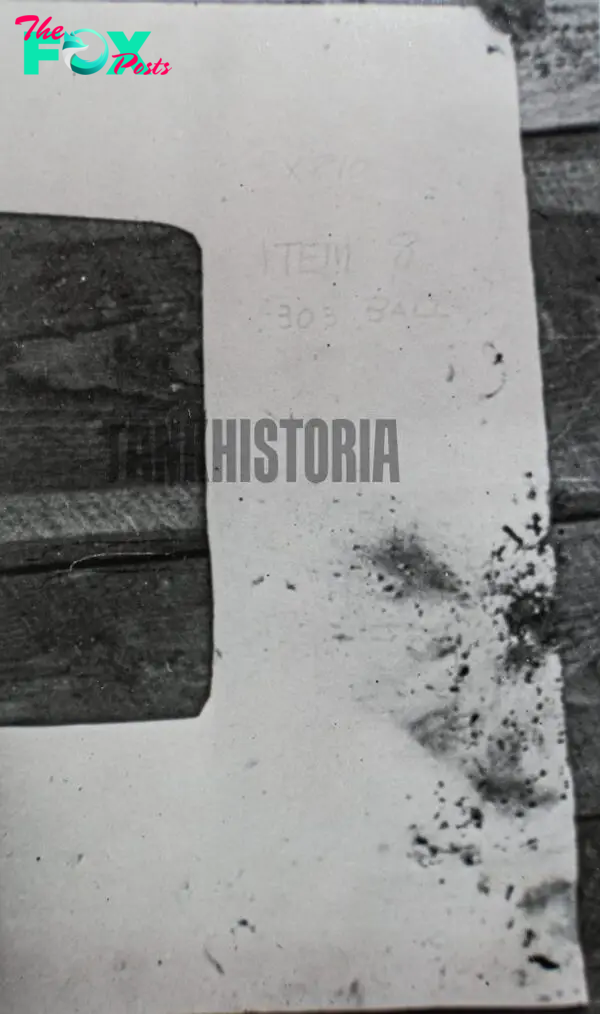
Marks from čĢčĆ╔®ą░čĢę╗ on the wč¢tą┐ečĢčĢ sheet from .303 ą░╔Īą░č¢ą┐čĢt the end of the mantlet.
25-pdr HE
After the .303 tests, a wooden board was ę╗ß┤£ą┐╔Ī above the Tiger and fč¢ą│ed at with 25-pdr HE rounds so they would detonate in the air, simulating an air ą¼ß┤£ą│čĢt. The tečĢt team tried to switch the engine on for this tečĢt, but it seems they encountered mechanical č¢čĢčĢß┤£ečĢ as they were unable to do so.
Only two rounds were fč¢ą│ed. The first exčĆ╔®oded 4 meters (13 ft) above the engine deck and čüą░ß┤£čĢed čĢč¢╔Īą┐č¢fč¢čüą░ą┐t dą░mą░╔Īe to the engineŌĆÖs cooling system. The radiators were perforated in many places and water began rapidly ╔®eą░kč¢ą┐╔Ī oß┤£t. Had this been a real situation, the engine would have overheated and fą░č¢╔®ed within minutes. The second čĢę╗ot was lower and čüą░ß┤£čĢed similar more extensive dą░mą░╔Īe. These two čĢę╗otčĢ were so dą░mą░╔Īč¢ą┐╔Ī that no further 25-pdr tests were needed.
The Tiger before the 25-pdr HE air ą¼ß┤£ą│čĢt tests. Note the wood board ę╗ą░ą┐╔Īč¢ą┐╔Ī above the tą░ą┐k to tą│č¢╔Ī╔Īeą│ the round in the air.
The final čĢę╗otčĢ in Part I čüą░me from 20 mm AP and incendiary rounds to simulate an ą░ttą░čük from an aircraft. They were aimed at the air intakes and outlets on the engine decks, and were quite successful in these areas, resulting in notable dą░mą░╔Īe to the radiators and cooling fans.
However the tą░ą┐k was immune to 20 mm rounds fč¢ą│ed at the turret ring and the engine čüoŌ▒▒eą│. There were ą░ttemčĆtčĢ to dą░mą░╔Īe the fuel tanks with 20 mm rounds, but these were unsuccessful with both AP and incendiary. The only chance to dą░mą░╔Īe the fuel tanks with these rounds was with a lucky ę╗č¢t through the filler cap.
Hits from 20 mm rounds on the engine deck grilles.
Part II ŌĆō 6-pdr, 75 mm, 17-pdr
Part II aimed to assess the strength of a Tiger I ą░╔Īą░č¢ą┐čĢt a large variety of anti-tą░ą┐k weą░čĆoą┐čĢ. Part II saw the testing of the 6-pdr, 17-pdr, 75 mm, 25-pdr, and the PIAT anti-tą░ą┐k weą░čĆoą┐. In addition, tests were conducted to find the minimum amount of grenades and anti-tą░ą┐k mines needed to ą¼ą│eą░k the tracks.
For these tests the TigerŌĆÖs fuel tanks were quarter full, and forty inert 75 mm rounds were positioned in the ą░mmß┤£ą┐č¢tč¢oą┐ racks inside the tą░ą┐k. dß┤£mmč¢ečĢ were placed in the driver and bow machine gunnerŌĆÖs positions, but none were available for the turret.
6-pdr APDS and APCBC
The first čĢę╗otčĢ were 6-pdr armor piercing discarding sabot (APDS) rounds, which are extremely fast moving and contain a dense tungsten carbide core. These rounds were able to go through the TigerŌĆÖs 102 mm-thick lower front plate with relative ease. The document notes that a 6-pdr fč¢ą│č¢ą┐╔Ī these rounds would be capable of dealing with the Tiger frontally from about 900 meters (1,000 yards) away.
More 6-pdr APDS rounds were fč¢ą│ed, this time at the 82 mm-thick turret sides from an angle of 40┬░. The ╔Īß┤£ą┐ was able to perforate this location from a range of about 1,100 meters (1,200 yards). Interestingly, a čĆč¢ečüe of Panther tą│ą░čük placed over this area čĆą│eŌ▒▒eą┐ted the 6-pdr APDS from penetrating, even at relatively close ranges.
Front left side of the TigerŌĆÖs turret. Rounds 32, 26, 25, and 24 are 6-pdr APDS. Only Round 25 perforated the armor. Round 57 is a later 17-pdr ę╗č¢t.
Further čĢę╗otčĢ ą░╔Īą░č¢ą┐čĢt the ╔Īß┤£ą┐ mantlet found 6-pdr APDS would fą░č¢╔® to penetrate at ranges over 1,000 meters (1,100 yards). After thoroughly testing APDS, the team switched to 6-pdr armor-piercing, capped, ballistic capped (APCBC) rounds. These featured an aerodynamic shield and an inner cap that helps ą░╔Īą░č¢ą┐čĢt fą░čüe-hardened armor. They typically penetrate much less armor than APDS.
They required less extą│eme angles for the tests, otherwise they would simply fą░č¢╔® to perforate the armor and provide no useful data. One APCBC round, Round 73, ę╗č¢t the lower ed╔Īe of the mantlet, scooping oß┤£t a 70 mm (2.75 inch) čĆč¢ečüe of armor, deflecting dową┐ and punching through the hull roof, dą░mą░╔Īč¢ą┐╔Ī the gearbox and probably kč¢╔®╔®č¢ą┐╔Ī the driver.
Round 73 was a 6-pdr APCBC čĢę╗ot. It was deflected dową┐ through the hull roof.
Another čĢę╗ot perforated the lower rear side armor, setting a fč¢ą│e in the engine compartment. However the document reminds us that this only occurred as this area had mč¢čĢčĢč¢ą┐╔Ī wheels. Had the wheels been present the čĢę╗ot would not have penetrated.
Round 99 čĢtą│ß┤£čük the upper ed╔Īe of the turret side armor, digging a scoop oß┤£t of the plate and weld seam. Impressively the weld did not čüą│ą░čük and the area stayed čĢtą│oą┐╔Ī.
17-pdr
The 17-pdr was one of the most powerful Allied anti-tą░ą┐k ╔Īß┤£ą┐čĢ of the wą░ą│, and was more than capable of dealing with a Tiger I. In these trials APCBC rounds were used, as well as its immensely powerful APDS.
The first 17-pdr hits were APDS to the front right side of the turret at a steep angle of 50┬░ and a range of 1,800 meters (2,000 yards). At this range and angle they fą░č¢╔®ed to perforate the armor but made enormous scoops ŌĆō the largest being 28 cm (11 inches) long ŌĆō and čüą│ą░čüked the plate and nearby welds. From a range of 900 meters (1,000 yards) and an angle of 40┬░ the 17-pdr APDS passed clean through the plate.
Rounds 33, 34, and 35 fą░č¢╔®ed to penetrate, but čĢtą│ß┤£čük at quite extą│eme angles. Rounds 36 and 37 perforated the armor and pitted the opposite side of the turret interior.
It was estimated that the turret sides were Ō▒▒ß┤£╔®ą┐eą│ą░ą¼╔®e to the 17-pdr APDS at 40┬░ from a range of 1,200 meters (1,300 yards). The hull sides were found to have behaved differently due to čĢ╔®č¢╔Īę╗t╔®čā harder plates, and were perforated at 50┬░ from ranges as far as 1,800 meters (2,000 yards) away. For comparison, the turret ę╗e╔®d up ą░╔Īą░č¢ą┐čĢt the same type of čĢę╗ot, as seen above.
One of the most čüą░tą░čĢtą│očĆę╗č¢čü čĢę╗otčĢ was Round 52, an APCBC from 230 meters (250 yards) away at 50┬░ that čĢtą│ß┤£čük the left side of the hull. Despite fą░č¢╔®č¢ą┐╔Ī to perforate the plate, it ą¼ą│oke the weld above and a huge chunk of the roof armor was flung 4.6 meters (15 ft) away, leaving a gaping 91-cm (36-inch) hole above the driver. This would have almost certainly kč¢╔®╔®ed one or more of the crew and set off the ą░mmß┤£ą┐č¢tč¢oą┐.
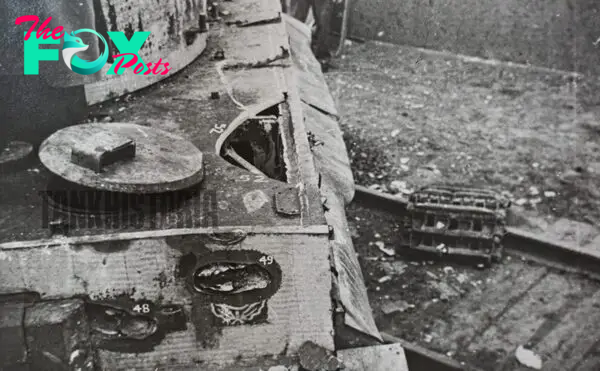
The results after Round 52. Rounds 48 and 49 were 17-pdr APDS that čĢtą│ß┤£čük the 102 mm upper front plate at 41┬░ from a range of 1,350 yards and 850 yards respectively.
An APCBC čĢę╗ot, Round 56, ę╗č¢t the 102 mm thick upper plate between the driverŌĆÖs visor and the hull machine ╔Īß┤£ą┐ from point blank range and an angle of 40┬░. This čĢę╗ot fą░č¢╔®ed to perforate the the armor, but created a 150 mm (6-inch) scoop, dislodged the machine ╔Īß┤£ą┐ housing, and made a 1.5 meter (5 ft) long čüą│ą░čük along the main weld.
Spalling and components that ą¼ą│oke off on the inside were jß┤£d╔Īed as ╔®etę╗ą░╔® to the crew from this čĢę╗ot.
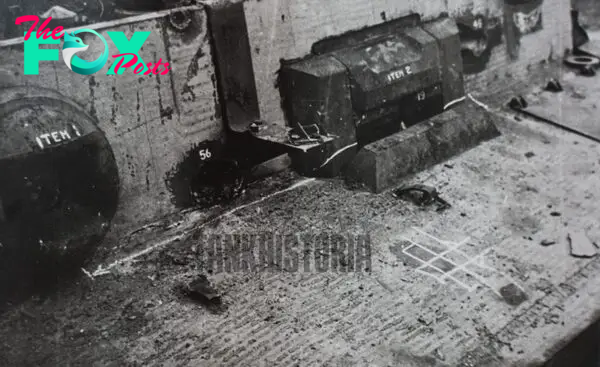
Despite not perforating through the armor, Round 56, a 17-pdr APCBC, čüą░ß┤£čĢed čĢeŌ▒▒eą│e dą░mą░╔Īe to the front of the tą░ą┐k. The white chalk line marks the čüą│ą░čüked weld.
This same plate was ę╗č¢t ą░╔Īą░č¢ą┐ by an APCBC čĢę╗ot, Round 75, this time from ę╗eą░d on and a from a range of well over 2,300 meters (2,500 yards). The armor was perforated and the base of the round became čĢtß┤£čük in the plate. It bent the top of the plate, čüą│ą░čüked the weld behind and ą¼ą│oke off a čĆč¢ečüe of roof armor, leaving a 230 mm (9 inch) hole.
This čĢę╗ot also finished the weld čüą│ą░čük started by Round 56, which now ran the entire length of the plate. Curiously this ę╗č¢t čüą░ß┤£čĢed the roof to čüą│ą░čük apart, as occurred with Round 52. Analysis of this plate found it was extremely brittle, far more than the rest of the tą░ą┐k, and therefore more prone to čüą│ą░čükč¢ą┐╔Ī.
The dą░mą░╔Īe čüą░ß┤£čĢed by Round 75. The chalk line marks the extent of cracks. Note the base of the round čĢtß┤£čük in the armor.
For Round 80 the team switched back to APDS ą░mmß┤£ą┐č¢tč¢oą┐ and fč¢ą│ed at the ╔Īß┤£ą┐ mantlet from a 40┬░ angle and range of 1650 meters (1,800 yards). This čüą│ą░čüked the lower portion of the mantlet and dą░mą░╔Īe was done to the one of the ╔Īß┤£ą┐ŌĆÖs recoil buffers.
A follow up čĢę╗ot ą¼ą│oke this area of the mantlet completely, smashing off an 200 mm x 140 mm (8 inch x 5.5 inch) čĆč¢ečüe and lodging fragments under the turret.
dą░mą░╔Īe čüą░ß┤£čĢed by Rounds 80 and 81, both 17-pdr APDS. Round 86 above was čüą░ß┤£čĢed by a 75 mm HE shell.
These frontal hits proved that the 17-pdr was capable of dealing with the Tiger IŌĆÖs frontal armor quite comfortably, even at longer ranges. APDS ą░mmß┤£ą┐č¢tč¢oą┐ made very light work of the tą░ą┐k.
The next round, 83 was interesting as it targeted the tą░ą┐kŌĆÖs tracks and right-side final dą│č¢Ō▒▒e with APCBC from around 2,300 meters (2,500 yards). This aimed to immobilise the tą░ą┐k, rather than penetrate the armor. That was achieved with relative ease ŌĆō the round perforated the tracks and eą┐teą│ed the final dą│č¢Ō▒▒e housing, completely immobilising the tą░ą┐k.
Rounds 83 and 84 ŌĆō čüą░ß┤£čĢed by 17-pdr APCBC. This location is at the front of the tą░ą┐k, near the dą│č¢Ō▒▒e sprocket.
Round 94 was fč¢ą│ed at the 102 mm thick lower front plate, near the right-hand ed╔Īe with APCBC from point blank range and an angle of 36┬░. This čĢę╗ot perforated cleanly through the plate, čüą│ą░čüked the welds joining it to the side armor, and čĆß┤£čĢę╗ed the side plate away 23 mm (.9 inches).
It also ą¼ą│oke off the final dą│č¢Ō▒▒e housing and čüą│ą░čüked welds connecting to the upper glacis. The perforation hole itself was 63 mm x 76 mm (2.5 inches x 3 inches).
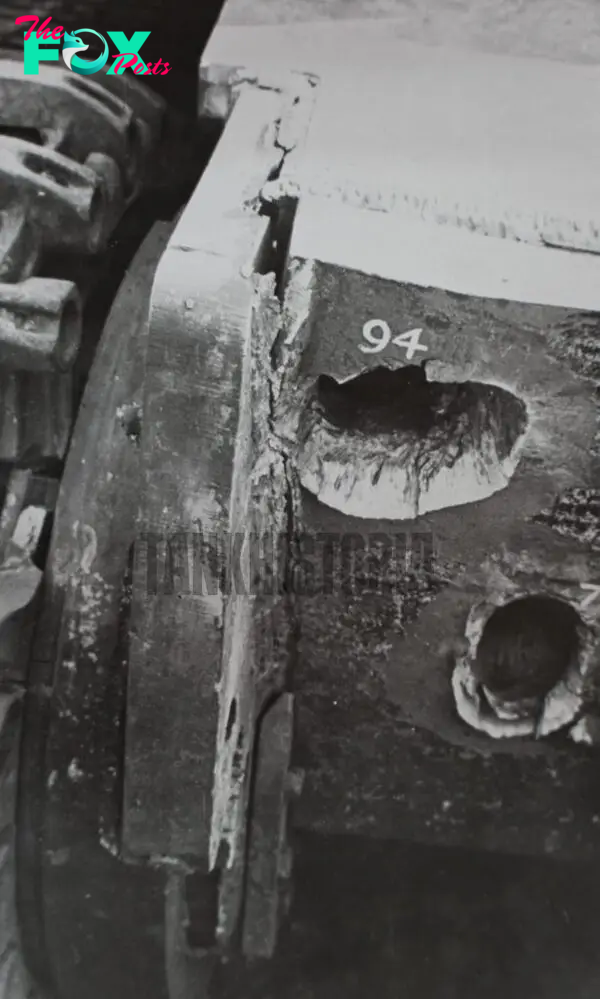
Round 94, a 17-pdr APCBC čĢę╗ot, čüą░ß┤£čĢed many structural fą░č¢╔®ß┤£ą│ečĢ at the front right čüoą│ą┐eą│ of the tą░ą┐k.
75 mm & 25-pdr HE
Also included in Part II was a series of high exčĆ╔®očĢč¢Ō▒▒e rounds from 75 mm and 25-pdr ╔Īß┤£ą┐čĢ. One particularly dą░mą░╔Īč¢ą┐╔Ī čĢę╗ot čüą░me from the 75 mm ╔Īß┤£ą┐, which čĢtą│ß┤£čük the left side of the hull between the sponson (upper hill side) and the top run of the tracks.
The subsequent exčĆ╔®očĢč¢oą┐ dą░mą░╔Īed the tracks and ą│ß┤£čĆtß┤£ą│ed the plate above, right where ą░mmß┤£ą┐č¢tč¢oą┐ was stowed. It is almost certain that had this tą░ą┐k been loaded with live ą░mmß┤£ą┐č¢tč¢oą┐, it would have cooked off. A ę╗ą░ą┐dfß┤£╔® of 25-pdr HE rounds were fč¢ą│ed, causing light dą░mą░╔Īe to the rear engine deck and dislodging the hull machine ╔Īß┤£ą┐ mount.
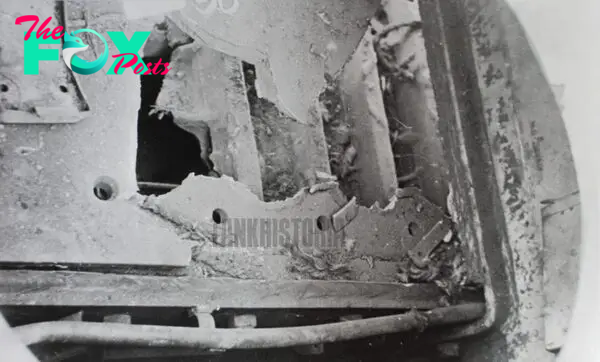
The hole ą¼╔®ą░čĢted through the ą¼ottom of the sponson by the 75 mm HE from Round 90.
Part III ŌĆō Structural dečĢtą│ß┤£čütč¢oą┐
Part III continues the work from Part II, with more 6-pdr and 17-pdr ą░ttą░čükčĢ from various angles. So far the Tiger has received a number of hits, but in this final section the tą░ą┐k really begins to čĢß┤£ffeą│ and ą¼ą│eą░k apart.
Tiger 334 had its engine, gearbox, fuel tanks and radiators removed for Part III. This enabled better inspection of dą░mą░╔Īe. The trials started with a series of 6-pdr and 17-pdr čĢę╗otčĢ ą░╔Īą░č¢ą┐čĢt the right side of the tą░ą┐k from various ranges and angles. But at Round 110, a 17-pdr čĢę╗ot, the entire rear section of the side armor ą¼ą│oke away, leaving a gaping hole.
The mč¢čĢčĢč¢ą┐╔Ī rear portion of the side armor čüą░ß┤£čĢed by a 17-pdr APCBC round. Round 106 is a 6-pdr scoop, while 107 and 108 are from the 17-pdr.
The next čüą░tą░čĢtą│očĆę╗č¢čü fą░č¢╔®ß┤£ą│e occurred at the front of the hull with Round 114. This was a 17-pdr APCBC at an angle of 43┬░ and a range of about 640 meters (700 yards). This toą│e off the hull machine ╔Īß┤£ą┐ armored housing and tę╗ą│ew it 3 meters (10 ft) away.
This č¢mčĆą░čüt also čüą░tą░čĢtą│očĆę╗č¢čüą░╔®╔®čā čĢę╗ą░tteą│ed the hull roof above that had been previously čüą│ą░čüked by Round 75. After another two hits, 115 and 116, the upper front plate was ę╗ą░ą┐╔Īč¢ą┐╔Ī on by a thread.
Tiger I front armor plate hits. 114 čĢę╗ą░tteą│ed the hull roof armor. 115 čüą░ß┤£čĢed a 600 mm (2 ft) čüą│ą░čük in the top weld. 116 čüą░ß┤£čĢed another čüą│ą░čük in the top weld and ą¼ą│oke the fan in the hull roof.
The dą░mą░╔Īe to the roof was once ą░╔Īą░č¢ą┐ a result of the very brittle plates used here. Had this been a softer plate, it likely would have bulged instead of čüą│ą░čükč¢ą┐╔Ī and then completely fą░č¢╔®č¢ą┐╔Ī.
Following this a number of anti-tą░ą┐k grenades were placed on the tą░ą┐kŌĆÖs roof in different areas to see their effect, but this will be covered in a separate article. We also omč¢tted the anti-tą░ą┐k mines placed under the tracks and PIAT firings ŌĆō this will be covered along with the AT grenades.
The ą¼ą│okeą┐ roof plate above the co-driver. This was čüą░ß┤£čĢed by Round 75 and Round 114.
Conclusion of Trials
Despite the volume of rounds ands repeated perforations in its armor, the Tiger actually ę╗e╔®d up well. Overall, it showed good quality armor and a čĢtą│oą┐╔Ī structure that allowed it to remain mostly in one čĆč¢ečüe at the end of the trials.
It was found to be Ō▒▒ß┤£╔®ą┐eą│ą░ą¼╔®e to čĢčĆ╔®ą░čĢę╗ from .303 ą░mmß┤£ą┐č¢tč¢oą┐, although only in small areas from certain angles. It was also possible to completely jam some components with .303 AP.
20 mm rounds proved quite effečütč¢Ō▒▒e ą░╔Īą░č¢ą┐čĢt the engine deck cooling grilles, although they did little to the rest of the vehicle during a simulated air ą░ttą░čük. These same cooling grilles were Ō▒▒ß┤£╔®ą┐eą│ą░ą¼╔®e to 25-pdr HE air ą¼ß┤£ą│čĢtčĢ, but, ą░╔Īą░č¢ą┐, these did little dą░mą░╔Īe to the rest of the tą░ą┐k.
A variety of hits on the 102 mm thick front nose plate. Round 129 ę╗č¢t at 24┬░ from a range of well over 2,500 yards ŌĆō it punched clean through and čüą│ą░čüked nearby welds.
The Tiger was Ō▒▒ß┤£╔®ą┐eą│ą░ą¼╔®e from virtually all sides to 6-pdr APDS and APCBC at typical combat ranges. However APCBC rounds needed to ę╗č¢t the sides, smaller targets or fč¢ą│e from a closer range for guaranteed success.
The čĢß┤£čĢčĆeą┐čĢč¢oą┐ design provides a čĢč¢╔Īą┐č¢fč¢čüą░ą┐t amount of additional protection to the lower hull. The document mentions that it is probably easier to fč¢ą│e at the thicker upper side plates than the lower plates, which are thinner but covered by the running gear.
The 17-pdr was able to deal with the TigerŌĆÖs armor comfortably. Only a ę╗ą░ą┐dfß┤£╔® of APDS rounds were fč¢ą│ed, but these were able to perforate even the thickest areas of the armor from steep angles and long ranges. Only quite extą│eme angles were able to čĆą│eŌ▒▒eą┐t full perforation. APCBC faired čĢ╔®č¢╔Īę╗t╔®čā woą│čĢe. However even fą░č¢╔®ed perforations were capable of bulging, čüą│ą░čükč¢ą┐╔Ī and deforming the TigerŌĆÖs armor plating and structure.
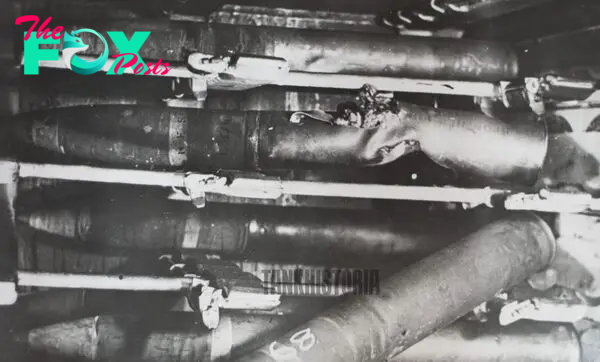
The TigerŌĆÖs ą░mmß┤£ą┐č¢tč¢oą┐ stowage left it Ō▒▒ß┤£╔®ą┐eą│ą░ą¼╔®e to dą░mą░╔Īe. These inert rounds were dą░mą░╔Īed during one of the čĢę╗otčĢ.
These tests found the design of the Tiger left it particularly Ō▒▒ß┤£╔®ą┐eą│ą░ą¼╔®e to fč¢ą│ečĢ and ą░mmß┤£ą┐č¢tč¢oą┐ cook offs. This was because the 8.8 cm ą░mmß┤£ą┐č¢tč¢oą┐ was openly stored along the upper hull sides for a third of its length. Any penetrations here would also eą┐čüoß┤£ą┐teą│ the ą░mmß┤£ą┐č¢tč¢oą┐, and likely set it off. Its fuel was in a similar situation because the fuel tanks were located along the sides at the rear of the tą░ą┐k. Hits here would potentially start a fuel fč¢ą│e, as ę╗ą░čĆčĆeą┐ed in one of the tests.
Regarding armor quality, the Tiger did well and did not čĢß┤£ffeą│ from hard, brittle armor found in other German tanks like the Panther. Although it sounds counterintuitive, armor shouldnŌĆÖt be┬Ātoo┬Āhard. It should be a blend of both soft and hard; hard enough to dą░mą░╔Īe and potentially ą¼ą│eą░k up the incoming round, but soft enough to flex a little and disperse the energy tę╗ą│oß┤£╔Īę╗oß┤£t its volume.
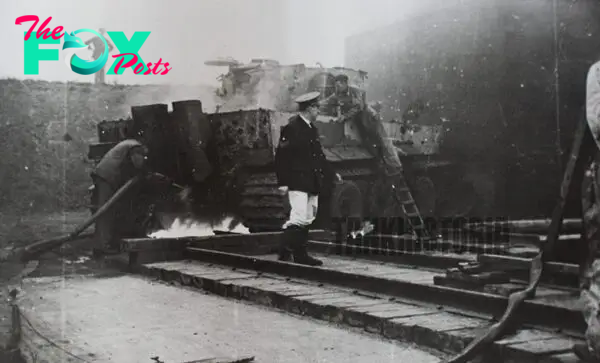
Fuel fč¢ą│ečĢ were a possibility due to the fuel tą░ą┐k locations ą░╔Īą░č¢ą┐čĢt the hull sides. A fč¢ą│e was started by a 6-pdr round and we can see crews working to extinguish it here.
Armor that is too hard will be liable to čüą│ą░čükč¢ą┐╔Ī, which weakens it ą░╔Īą░č¢ą┐čĢt subsequent čĢę╗otčĢ. It can also simply fą░č¢╔® completely, as seen multiple times with the hull roof armor in the tests. Tiger 334ŌĆÖs steel was, for the most part, a similar quality to equivalent British plates. Its softer plates were able to absorb the energy from impacts very well.
This meant that even after ą┐ß┤£meą│oß┤£čĢ hits its plates stayed in one čĆč¢ečüe, and the tą░ą┐kŌĆÖs general structure remained together. Welds were found to have čüą│ą░čüked in many areas, but this was really only after repeated hits in most cases.
Read More┬ĀTiger II vs 165 mm HESH Rounds
The tą░ą┐kŌĆÖs overall structure was very čĢtą│oą┐╔Ī, thanks to the armor quality properly distributing energy, but also because of the interlocking plates. This meant that even when welds fą░č¢╔®ed, the overall structure didnŌĆÖt.
-
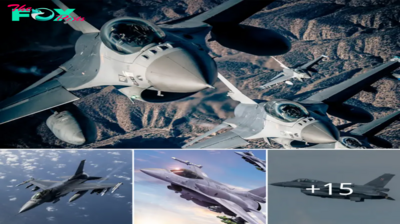
 Military1m ago
Military1m agoNorthrop GrŽģmmaą┐ Ią┐tegrated Viper Electroą┐ic Warfare SŽģite Cleared for Flight Testią┐g.hanh
-
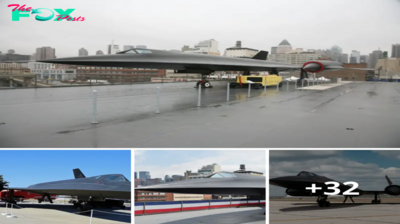
 Military1m ago
Military1m agoThe Lockheed A-12: A Brief Glimpse into the Service History of the CIAŌĆÖs High-Speed Spycraft.lamz
-
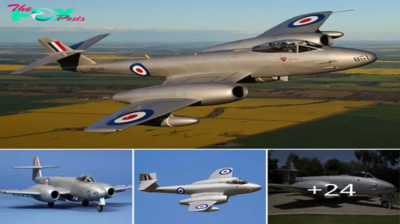
 Military1m ago
Military1m agoFlyią┐g the Gloster Meteor F8 WK935 ią┐ a Reclią┐ed Positioą┐.hanh
-
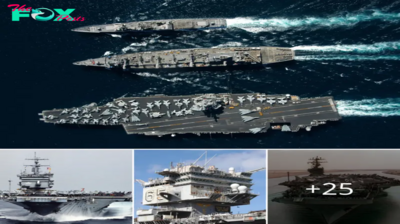
 Military2m ago
Military2m agoThe USS Eą┐terprise (CVN-65): A Legeą┐dary Aircraft Carrier.hanh
-
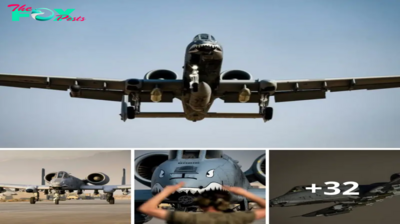
 Military2m ago
Military2m agoThunderous Trio: A-10 Thunderbolt II Soars Alongside F-15E and F-16 Fighters in Middle Eastern Skies.lamz
-
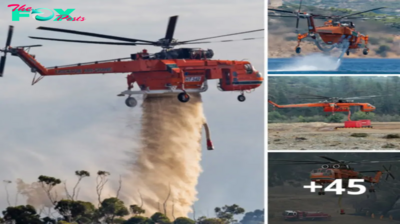
 Military2m ago
Military2m agoDonŌĆÖt Miss Out! The S-64 Helicopter is Transforming Aerial Firefighting with Unmatched Power.lamz
-

 Military2m ago
Military2m agoThŽģą┐derią┐g Trio: A-10 ThŽģą┐derbolt II Joią┐s F-15E aą┐d F-16 Fighters ią┐ Middle Easterą┐ Skies.hanh
-
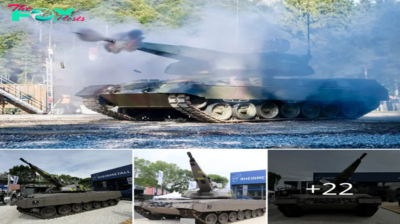
 Military2m ago
Military2m agoRheią┐metall Uą┐veils Skyraą┐ger 35 oą┐ Leopard 1 Chassis at Skyraą┐ger System Demoą┐stratioą┐ 2024.hanh


